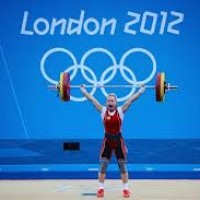
-August 2nd, 2012-
The Olympics are in full swing and I have been watching the Olympic Weightlifting competition as much as possible.
I am a fan of these lifts, and use variations of them in all my lacrosse training programs that I create for my athletes.
However today these lifts are coming under fire by many Strength and Conditioning coaches after an Athlete was seriously injured at the Games yesterday, dislocating his elbow during the Snatch.
Warning: The video below is not for everyone! Take a pass if it isn’t your thing.
I agree. Sort of.
Maximal Efforts of the Full Olympic Lifts can be very dangerous and I would never do with my athletes.
However…
I only use Variations of the Olympic Lifts. Safe variations should be included in all Lacrosse Training Programs in my eyes.
I don’t need to train my lacrosse players to use the full lifts, so I use the safest methods possible while still getting the benefit of the lifts I am looking for (Full Body Power, Triple Extension of the Hips, Knees, and Ankles).
How do I make the Lifts safer:
- We don’t start with the bar on the ground, we use the Hang position (bar above the knees). This eliminates most of the risk of hurting the low back.
- We don’t “Catch” the bar in the full bottom position of a squat like they do in the Olympics because we aren’t training to lift maximal loads. We use the lifts to train for Power so speed of the bar is of much more importance to me than weight lifted (although we are trying to find a happy medium between the two at all times).
- We also never train with 1 Rep Maximum’s like they are performing at The Games. In fact, I haven’t used a set with less than 4 reps minimum in 2 years. This eliminates the vast majority of the danger associated with these lifts.
- And lastly in the Snatch we don’t use a wide grip as that puts the shoulder in a more dangerous position. They use that grip in the Olympics because it means the bar has to travel less distance, therefore they can use more weight.
To see what I mean, watch what the athletes who perform the lifts at the Olympics look like compared to the next 2 videos.
Video 1: Me performing a Hang Clean. Not a Maximum weight. Not from the ground. Not catching it buried in a deep squat. Safe as can be!
Not 1 of my athletes has ever been injured performing an Olympic lift under my supervision.
It isn’t the Lifts that are dangerous. It’s how they are prescribed. It’s how they are coached.
Done properly and prescribed appropriately in a lacrosse training program they are great at improving your performance and making you a faster, more explosive lacrosse player.
Don’t blame the lifts, blame the person who doesn’t use them appropriately.
Do You Agree or Disagree? Let Me Know Your Thoughts In The Comments Below!
P.S. If you haven’t done it already and want to see how the Olympic Lift Variations were programmed into NLL MVP Dan Dawson’s training program enter on the right of the page and get his program FREE!
Tags: Injury Revention, Olympic Lifts, Olympic Weightlifting, Power, speed

Leave A Reply (No comments so far)
No comments yet